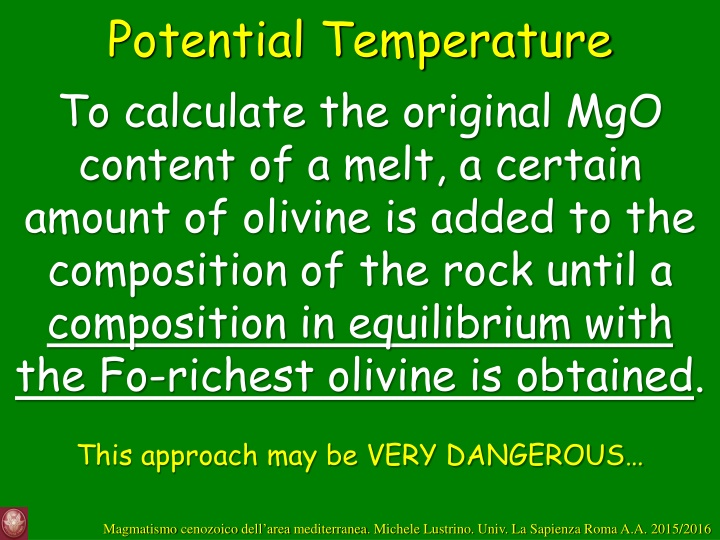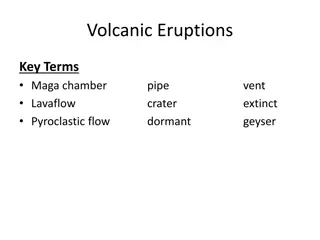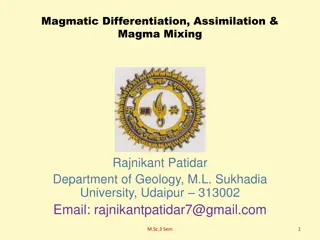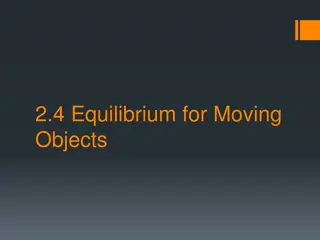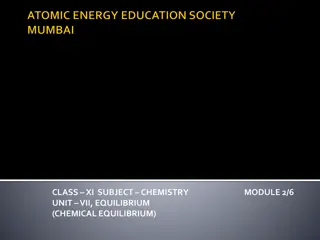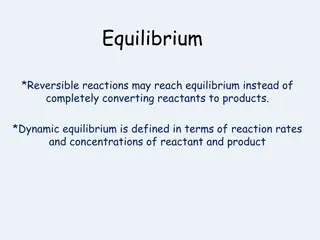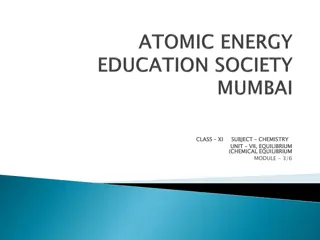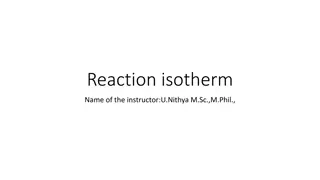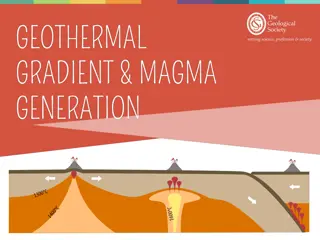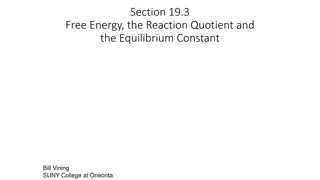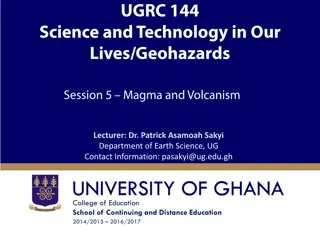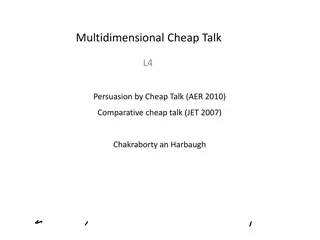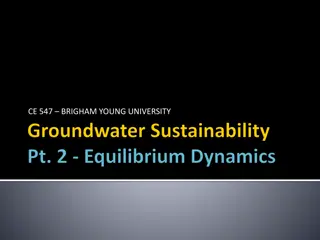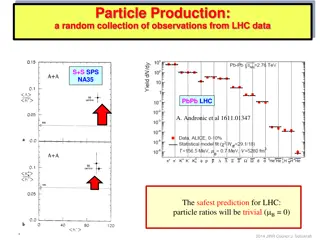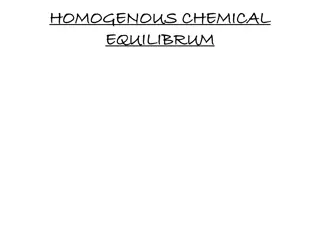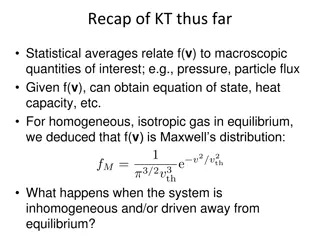Olivine Equilibrium in Calculating Original Magma Composition
The process involves analyzing olivine in basaltic rocks, selecting olivine with the highest Fo content, calculating the melt composition in equilibrium with this olivine using the distribution coefficient (KD), and determining the potential temperature (Tp) based on the MgO content. The distribution coefficient KD relates the partitioning of Fe and Mg between olivine and liquid, with a typical value of 0.30. This method helps estimate the hypothetical composition of the original magma before olivine crystallization.
Download Presentation

Please find below an Image/Link to download the presentation.
The content on the website is provided AS IS for your information and personal use only. It may not be sold, licensed, or shared on other websites without obtaining consent from the author.If you encounter any issues during the download, it is possible that the publisher has removed the file from their server.
You are allowed to download the files provided on this website for personal or commercial use, subject to the condition that they are used lawfully. All files are the property of their respective owners.
The content on the website is provided AS IS for your information and personal use only. It may not be sold, licensed, or shared on other websites without obtaining consent from the author.
E N D
Presentation Transcript
Potential Temperature To calculate the original MgO content of a melt, a certain amount of olivine is added to the composition of the rock until a composition in equilibrium with the Fo-richest olivine is obtained. This approach may be VERY DANGEROUS Magmatismo cenozoico dell area mediterranea. Michele Lustrino. Univ. La Sapienza Roma A.A. 2015/2016
Potential Temperature Follow this sequence: 1) Analyze with EMP olivine in basaltic rocks; 2) Select the olivine with the highest Fo; 3) Calculate the composition (the MgO content) of the melt in equilibrium with this olivine assuming the relation: KD= (FeOol)/(FeOmelt) * (MgOmelt)/(MgOol) 4) On the basis of this MgO content (higher than that really measured in the rock) calculate the Tp using the relation:Tp(oC)=1463+12.74*MgO-2924/MgO 5) Often it is calculated the hypothetical composition of the original magma, before olivine crystallization. This is done adding olivine to the melt till approaching the hypothetical composition. Magmatismo cenozoico dell area mediterranea. Michele Lustrino. Univ. La Sapienza Roma A.A. 2015/2016
Potential Temperature The distribution coefficient: KD= (FeOol)/(FeOmelt)*(MgOmelt)/(MgOol) relates the partitioning of Fe and Mg between olivine and liquid. It has been calculated independent of temperature and equal to 0.30 in 1970 (Roeder and Emslie, Contrib. Mineral. Petrol.). Following studies have slightly modified the value of this KDto 0.31-0.35, no more. Magmatismo cenozoico dell area mediterranea. Michele Lustrino. Univ. La Sapienza Roma A.A. 2015/2016
Potential Temperature The distribution coefficient: KD= (FeOol)/(FeOmelt)*(MgOmelt)/(MgOol) Falloon et al. (2007) Chem. Geol., 241, 207-233 KD(FeOmelt/FeOol)*(MgOol/MgOmelt) Magmatismo cenozoico dell area mediterranea. Michele Lustrino. Univ. La Sapienza Roma A.A. 2015/2016
Potential Temperature The distribution coefficient: KD= (FeOol)/(FeOmelt)*(MgOmelt)/(MgOol) Magmatismo cenozoico dell area mediterranea. Michele Lustrino. Univ. La Sapienza Roma A.A. 2015/2016
Potential Temperature The distribution coefficient: KD= (FeOol)/(FeOmelt)*(MgOmelt)/(MgOol) What does a KD= 0.30 mean? We can write the KD also in a different way: KD= (FeO/MgO)ol/(FeO/MgO)melt Let us assume an olivine that crystallizes from a basaltic melt. Does this olivine have higher Fe/Mg ratio than the liquid? This means that, starting from a given Fe/Mg in the melt, what is the element preferentially allocated into olivine? Mg Magmatismo cenozoico dell area mediterranea. Michele Lustrino. Univ. La Sapienza Roma A.A. 2015/2016
Potential Temperature The distribution coefficient: KD= (FeOol)/(FeOmelt)*(MgOmelt)/(MgOol) Do you remember this diagram? The olivine in equilibrium with a melt is always richer in MgO. This means that olivine has lower FeO/MgO than the melt. Magmatismo cenozoico dell area mediterranea. Michele Lustrino. Univ. La Sapienza Roma A.A. 2015/2016
Potential Temperature The distribution coefficient: KD= (FeOol)/(FeOmelt)*(MgOmelt)/(MgOol) Let us make an example: FeOol= 20.90 wt%; MgOol= 37.70 wt%. FeOmelt= 9.20 wt%; MgOmelt= 7.50 wt%. KD= ? KD= (0.291/0.128)*(0.187/0.935) = 0.46 ? KDshould be 0.30, why we obtained 0.46? KD= (FeO/MgO)ol/(FeO/MgO)melt First divide the wt% per molecular weights FeO = 71.85; MgO = 40.31 Magmatismo cenozoico dell area mediterranea. Michele Lustrino. Univ. La Sapienza Roma A.A. 2015/2016
Potential Temperature 1.0 KD 0.2 0.9 0.8 KD 0.1 0.7 Fo (Mg# ol) 0.6 KD 0.8 0.5 KD 0.6 Mg# = Mg/(Mg+Fe) 0.4 KD 0.4 0.3 0.2 KD = 1 means identical distribution of Fe/Mg (or Mg#) between melt and olivine. This is the base (wrong) assumption of CIPW norm. 0.1 0.0 0.0 0.1 0.2 0.3 0.4 Mg# melt 0.5 0.6 0.7 0.8 0.9 1.0 Magmatismo cenozoico dell area mediterranea. Michele Lustrino. Univ. La Sapienza Roma A.A. 2015/2016
Potential Temperature 1.0 KD 0.2 0.9 0.8 KD 0.1 0.7 Fo (Mg# ol) 0.6 KD 0.8 0.5 KD 0.6 0.4 KD 0.4 0.3 0.2 Next slide 0.1 0.0 0.0 0.1 0.2 0.3 0.4 Mg# melt 0.5 0.6 0.7 0.8 0.9 1.0 Magmatismo cenozoico dell area mediterranea. Michele Lustrino. Univ. La Sapienza Roma A.A. 2015/2016
Potential Temperature 1.0 Mg# in olivine (Fo content) 0.8 0.6 Each color represents one sample. In each sample coexist olivines with different compositions (Fo) 0.4 0.2 In theory all the olivines should plot along the red line, but... 0 0.3 0.4 0.5 0.6 0.7 Mg# in melt Magmatismo cenozoico dell area mediterranea. Michele Lustrino. Univ. La Sapienza Roma A.A. 2015/2016
Potential Temperature 1.0 Mg# in olivine (Fo content) 0.8 0.6 Olivines above the red line have too much Mg to have been crystallized from that melt. 0.4 0.2 Nearly all the analyzed olivines are not in equilibrium with the melt 0 0.3 0.4 0.5 0.6 0.7 Mg# in melt Magmatismo cenozoico dell area mediterranea. Michele Lustrino. Univ. La Sapienza Roma A.A. 2015/2016
Potential Temperature 1.0 Mg# in olivine (Fo content) 0.8 0.6 Olivines below the red line have too low Mg to have been crystallized from that melt. Nearly all the analyzed olivines are not in equilibrium with the melt 0.4 0.2 0 0.3 0.4 0.5 0.6 0.7 Mg# in melt Magmatismo cenozoico dell area mediterranea. Michele Lustrino. Univ. La Sapienza Roma A.A. 2015/2016
Potential Temperature 1.0 Mg# in olivine (Fo content) 0.8 0.6 How is it possible to have olivine Fo- richer (Mg-richer) than equilibrium olivine? How is it possible to have olivine Fo-poorer (Fe-richer) than equilibrium olivine? Recycling of late crystallization phases 0.4 Xenocrysts 0.2 0 0.3 0.4 0.5 0.6 0.7 Mg# in melt Magmatismo cenozoico dell area mediterranea. Michele Lustrino. Univ. La Sapienza Roma A.A. 2015/2016
Potential Temperature 1.0 Mg# in olivine (Fo content) 0.8 0.6 Is it correct to say that the TRUE Mg# of the melt is that calculated considering the olivine with the highest Fo? 0.4 0.2 0 0.3 0.4 0.5 0.6 0.7 Mg# in melt Magmatismo cenozoico dell area mediterranea. Michele Lustrino. Univ. La Sapienza Roma A.A. 2015/2016
Potential Temperature There are several problems in transforming the Fo content in olivine into temperature estimates: 1) There are no olivine-controlled trends for MORB glasses. Except for the Puna Ridge trend, all of the olivine-controlled trends are artificially produced by adding olivine back into observed glass compositions. Magmatismo cenozoico dell area mediterranea. Michele Lustrino. Univ. La Sapienza Roma A.A. 2015/2016
Potential Temperature Di MORB glasses MORB glasses (Mg#>68) X Iceland glasses Puna Ridge glasses from Kilauea Experimental glasses Pl Ol Presnall and Gudfinnsson (2011) J. Petrol., 52, 1533-1546 Magmatismo cenozoico dell area mediterranea. Michele Lustrino. Univ. La Sapienza Roma A.A. 2015/2016
Potential Temperature There are several problems in transforming the Fo content in olivine into temperature estimates: 2) The Fo-richest olivine can be fragments of the mantle, not liquidus olivine. A detailed chemical and petrographic investigation is fundamental to distinguish the two types of olivines. Magmatismo cenozoico dell area mediterranea. Michele Lustrino. Univ. La Sapienza Roma A.A. 2015/2016
Potential Temperature There are several problems in transforming the Fo content in olivine into temperature estimates: 3) The high Fo content of olivine can be related to Fe-poor mantle. A depleted mantle is Fe-poor and Mg-rich. Partial melts of this source will be Fe-poor and Mg-rich and have high Mg#. Olivine crystallizing from this kind of melts will be Fe-poor and, therefore, Fo-rich. Magmatismo cenozoico dell area mediterranea. Michele Lustrino. Univ. La Sapienza Roma A.A. 2015/2016
Potential Temperature Magmatismo cenozoico dell area mediterranea. Michele Lustrino. Univ. La Sapienza Roma A.A. 2015/2016
Potential Temperature There are several problems in transforming the Fo content in olivine into temperature estimates: 4) Melts generated after high degrees of melting are characterized by high Mg# and, consequentially,willcrystallizeFo-rich olivine. It is not necessary to have high T to generate high amount of melting. Melting can be generated with volatile flushing (H and C, above all) and with the presence of low- solidus olivine-poor lithologies (eclogites). Magmatismo cenozoico dell area mediterranea. Michele Lustrino. Univ. La Sapienza Roma A.A. 2015/2016
Potential Temperature There are several problems in transforming the Fo content in olivine into temperature estimates: 4) Melts generated after high degrees of melting are characterized by high Mg# and, consequentially,willcrystallizeFo-rich olivine. If an upwelling mantle melts at high depths, it will experience more and more melting moving to the surface. Magmatismo cenozoico dell area mediterranea. Michele Lustrino. Univ. La Sapienza Roma A.A. 2015/2016
Potential Temperature There are several problems in transforming the Fo content in olivine into temperature estimates: 5) Fo-rich olivines can crystallize in a highly oxidized melt. If Fe3+become particularly abundant in specific conditions magnetite crystallization is favoured. This depletes the residual magma in Fe2+. Late olivine can crystallize with MgO-rich (up to Fo99) compositions. Magmatismo cenozoico dell area mediterranea. Michele Lustrino. Univ. La Sapienza Roma A.A. 2015/2016
Potential Temperature There are several problems in transforming the Fo content in olivine into temperature estimates: 6) Fo-rich olivines can be generated after subsolidus substitution with spinel. Cr-rich spinel prefers Fe (forming chromite Fe2+Cr2O4) rather than Mg (Mg-chromite MgCr2O4). If olivine is present, it will exchange Fe with chromite, accepting Mg from the spinel. The result will be Fo-rich olivine. Magmatismo cenozoico dell area mediterranea. Michele Lustrino. Univ. La Sapienza Roma A.A. 2015/2016
Potential Temperature There are several problems in transforming the Fo content in olivine into temperature estimates: 7) If present, phlogopite in the mantle melts incongruently giving K-OH-rich melt + Fo- rich (up to Fo95) peritectic olivine. This SiO2-undersaturated K-OH-rich melt reacts with mantle enstatite dissolving it. In this way the melt becomes MgO-rich (18-30 wt% MgO) and with high Mg#. Olivine crystallizing from this melt will be Fo-rich. Prelevic (2015, written communication) Magmatismo cenozoico dell area mediterranea. Michele Lustrino. Univ. La Sapienza Roma A.A. 2015/2016
Potential Temperature There are several problems in transforming the Fo content in olivine into temperature estimates: 8) If present, phlogopite in the mantle melts incongruently giving K-OH-rich melt + Fo- rich (up to Fo95) peritectic olivine. Possible subsequent melting of this phlogopite-free mantle, rich in Fo-rich peritectic olivine, can produce Mg# rich melts that can crystallize Fo-rich olivines. Prelevic (2015, written communication) Magmatismo cenozoico dell area mediterranea. Michele Lustrino. Univ. La Sapienza Roma A.A. 2015/2016
Potential Temperature There are several problems in transforming the Fo content in olivine into temperature estimates: 9) Fo-rich (up to Fo93) olivine forms as liquidus phase of a MARID melt. MARID rocks are lithologies composed essentially of Mica + Amphibole, Rutile, Ilmenite and Diopside. MARID partial melts are Mg-rich and crystallize Fo-rich olivine, but at normal to relatively low temperatures. Prelevic (2015, written communication) Magmatismo cenozoico dell area mediterranea. Michele Lustrino. Univ. La Sapienza Roma A.A. 2015/2016
Potential Temperature There are several problems in transforming the Fo content in olivine into temperature estimates: 10) Fo-rich (up to Fo94) olivine forms in a melt derived from dolomite-bearing mantle. Dolomite is the stable carbonate in the ~2-3 GPa depth range. A mixed carbonatitic- silicatic melt with cooling can split the MgO content of dolomite forming Fo-rich olivine, leaving CaO-rich carbonatite, which can eventually collapse at P <2GPa. Prelevic (2015, written communication) Magmatismo cenozoico dell area mediterranea. Michele Lustrino. Univ. La Sapienza Roma A.A. 2015/2016
Potential Temperature 1) Picritic magmas (Olivine- and MgO-rich tholeiites) from Hawaii show high-Fo olivines (Fo88-91). 2) The magma in equilibrium with the highest Fo olivines must have ~ 15-16 wt.% MgO. 3) The calculated MgO composition is typically higher than the measured whole-rock MgO composition. 4) It is possible to calculate the temperature of formation of a magma using geothermometers (olivine-melt Fe/Mg exchange). 5) The geothermometric results for the Hawaiian picrites indicate liquidus temperature ~1315 C. From Green et al. (2001) Eur. J. Mineral., 13, 437-451 Magmatismo cenozoico dell area mediterranea. Michele Lustrino. Univ. La Sapienza Roma A.A. 2015/2016
Potential Temperature 1) The most MgO-rich MORB have 13-14 wt.% MgO. 2) The most magnesian olivines of these picritic MORB reach Fo91-92. 3) As observed for the Hawaiian picrites, the calculated MgO composition is typically higher than the measured whole-rock MgO composition. 4) It is possible to calculate the temperature of formation of a magma using geothermometers (olivine-melt Fe/Mg exchange). 5) The geothermometric results for the MORB picrites indicate liquidus temperature ~1325 C. From Green et al. (2001) Eur. J. Mineral., 13, 437-451 Magmatismo cenozoico dell area mediterranea. Michele Lustrino. Univ. La Sapienza Roma A.A. 2015/2016
